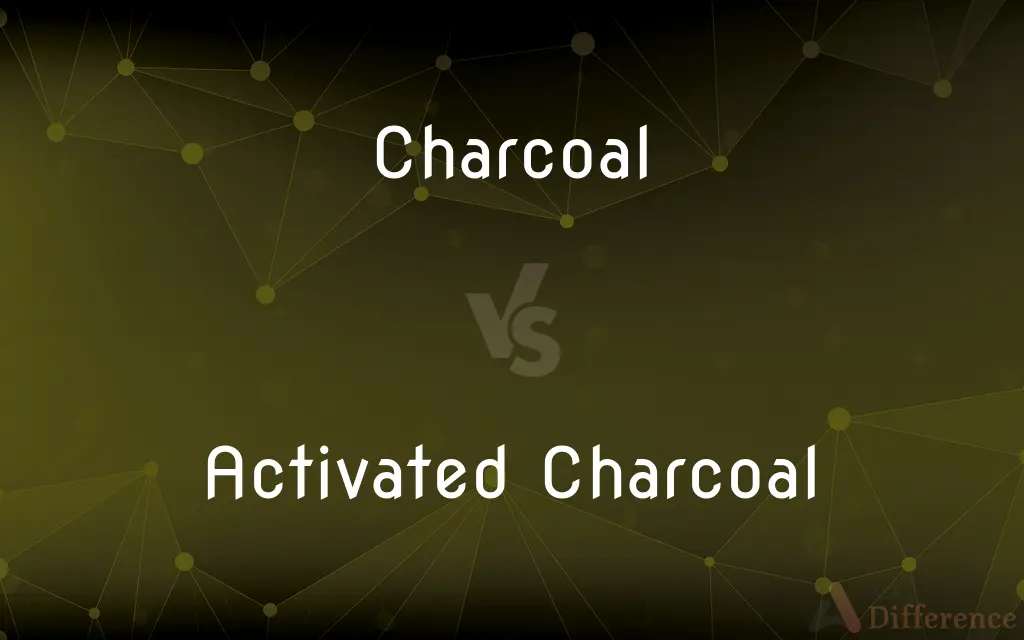Charcoal vs. Activated Charcoal — What's the Difference?
By Tayyaba Rehman & Maham Liaqat — Published on November 11, 2024
Charcoal is a lightweight, black residue, produced by removing water and other volatile constituents from plant materials. Activated charcoal undergoes an additional process to increase its adsorptive power, making it highly effective at trapping toxins.

Difference Between Charcoal and Activated Charcoal
Table of Contents
ADVERTISEMENT
Key Differences
Charcoal is traditionally used as a fuel source for heating and cooking due to its ability to burn at high temperatures with little smoke. It's produced through the process of pyrolysis, which involves heating organic materials, such as wood, in the absence of oxygen, resulting in a carbon-rich substance. Charcoal can also be used for drawing and in certain filtration processes due to its porous nature.
Activated charcoal, on the other hand, is specifically processed to create a vast network of smaller pores, increasing its surface area dramatically. This enhancement is typically achieved through physical or chemical activation methods, involving high temperatures and agents like steam or chemicals. The increased surface area allows activated charcoal to adsorb much larger quantities of substances compared to regular charcoal, making it highly effective for medical applications, detoxification, water purification, and air filtration.
Both charcoal and activated charcoal share the basic component of carbon, but their uses diverge significantly due to the differences in their physical properties. Regular charcoal is primarily valued for its heat-generating capacity, while activated charcoal is sought after for its ability to purify and cleanse by removing impurities from liquids and gases.
The selection between charcoal and activated charcoal depends on the intended use. For cooking and heating, regular charcoal is preferred for its efficiency and cost-effectiveness. In contrast, for filtering water, treating poisonings and overdoses, air purification, and skincare, activated charcoal is the choice due to its enhanced adsorption capabilities.
Despite the benefits of activated charcoal, its powerful adsorptive qualities require cautious application, especially in medical contexts, where it can interfere with the absorption of medications and nutrients when ingested.
ADVERTISEMENT
Comparison Chart
Production
Made by heating wood or other organic materials without oxygen.
Produced from charcoal by heating it with a gas that causes the charcoal to expand, creating a porous surface.
Pore Size
Larger, less uniform pores.
Smaller, more uniform pores resulting in a larger surface area.
Adsorption Capacity
Limited due to smaller surface area.
High adsorption capacity due to increased surface area and porosity.
Primary Use
Fuel for heating and cooking, drawing material.
Medical applications, water and air purification, detoxification.
Cost
Generally less expensive.
More expensive due to additional processing.
Compare with Definitions
Charcoal
Charcoal is a porous black solid, obtained as a residue when wood is heated in the absence of oxygen.
Charcoal is widely used in barbecues for grilling.
Activated Charcoal
It can adsorb gases and reduce bad smells.
Activated charcoal is used in air purifiers to filter indoor air pollutants.
Charcoal
It serves as a traditional drawing material in art.
Artists value charcoal for its ability to create rich blacks and varied textures.
Activated Charcoal
Due to its porosity, it's effective in detoxifying applications.
Activated charcoal supplements are marketed for detox and cleansing purposes.
Charcoal
Charcoal can be used in basic filtration systems.
Charcoal filters are employed in some types of water purification systems.
Activated Charcoal
Activated charcoal is used in skincare products to draw out impurities from pores.
Face masks containing activated charcoal can help clear acne.
Charcoal
Charcoal has limited adsorptive properties compared to activated charcoal.
While useful for some filtration, charcoal cannot adsorb toxins as effectively as activated charcoal.
Activated Charcoal
It's utilized in water purification systems to remove impurities.
Activated charcoal filters can remove chlorine and odors from water.
Charcoal
It is preferred for the smoky flavor it imparts in cooking.
Cooking with charcoal adds a distinct flavor to grilled foods.
Activated Charcoal
Activated charcoal is treated to increase its adsorptive power, making it effective at trapping chemicals.
It's used in emergency rooms to treat certain kinds of poisoning.
Charcoal
A black, porous, carbonaceous material, 85 to 98 percent carbon, produced by the destructive distillation of wood and used as a fuel, filter, and adsorbent.
Charcoal
Impure carbon obtained by destructive distillation of wood or other organic matter, that is, heating it in the absence of oxygen. Category:en:Carbon
Charcoal
Impure carbon prepared from vegetable or animal substances; esp., coal made by charring wood in a kiln, retort, etc., from which air is excluded. It is used for fuel and in various mechanical, artistic, and chemical processes.
Charcoal
A carbonaceous material obtained by heating wood or other organic matter in the absence of air
Charcoal
Draw, trace, or represent with charcoal
Charcoal
Very dark gray
Common Curiosities
Is activated charcoal safe to ingest?
Activated charcoal is safe for use in certain medical situations, such as poisoning, under professional supervision. However, indiscriminate use can lead to absorption issues and should be avoided without medical advice.
How is activated charcoal "activated"?
Activated charcoal is created by heating regular charcoal in the presence of a gas that causes the charcoal to develop internal spaces or "pores," which increase its ability to adsorb substances.
Does cooking with charcoal impart any health risks?
Cooking with charcoal can produce carcinogenic compounds if food is charred or exposed to high heat and smoke. It's important to cook carefully to minimize these risks.
Can I use regular charcoal instead of activated charcoal for purifying water?
No, regular charcoal lacks the pore structure and surface area of activated charcoal, making it much less effective for purifying water.
Can activated charcoal remove toxins from the body?
Yes, activated charcoal can bind to toxins and chemicals in the gastrointestinal tract, preventing their absorption and facilitating their elimination from the body.
How long does activated charcoal take to work in cases of poisoning?
Activated charcoal works most effectively if taken within 1 hour of ingesting a toxin. Its efficacy decreases the longer the delay between ingestion of the poison and the charcoal.
Can both charcoal and activated charcoal be used for odor control?
While both can be used for odor control, activated charcoal is far more effective due to its larger surface area and increased adsorption capacity.
Do charcoal and activated charcoal have a shelf life?
Charcoal itself does not have a shelf life and can be stored indefinitely if kept dry. Activated charcoal should be stored in a sealed container to maintain its efficacy, but it does not technically expire.
Can activated charcoal affect medication absorption?
Yes, activated charcoal can adsorb and inhibit the absorption of certain medications if taken simultaneously, which is why a healthcare provider should be consulted before its use.
Is it safe to use activated charcoal daily for detoxification?
Regular use of activated charcoal for detoxification is not recommended without consulting a healthcare professional, as it can lead to nutrient absorption issues and dehydration.
Can I make activated charcoal at home?
Making activated charcoal at home is not recommended due to the need for controlled conditions, high temperatures, and specific activation processes to ensure its effectiveness and safety.
How are charcoal and activated charcoal disposed of safely?
Charcoal can be disposed of in general waste once it has cooled completely and poses no fire risk. Activated charcoal should be disposed of as advised by local waste management regulations, especially if used for hazardous substance adsorption.
How does the adsorption process of activated charcoal work?
Adsorption by activated charcoal involves the adhesion of atoms, ions, or molecules from a gas, liquid, or dissolved solid to its surface, creating a thin film on the adsorbent's surface without absorbing the substances internally.
Can charcoal be made from materials other than wood?
Yes, charcoal can also be made from other organic materials, including coconut shells, peat, and bamboo, each with unique properties and uses.
Are there environmental concerns associated with the production of charcoal or activated charcoal?
The production of charcoal, especially from wood, can contribute to deforestation and greenhouse gas emissions. Sustainable practices and sourcing, as well as the use of byproducts and waste materials, can mitigate some environmental impacts.
Share Your Discovery

Previous Comparison
Tablet vs. Pda
Next Comparison
Urgent Care vs. Walk In ClinicAuthor Spotlight
Written by
Tayyaba RehmanTayyaba Rehman is a distinguished writer, currently serving as a primary contributor to askdifference.com. As a researcher in semantics and etymology, Tayyaba's passion for the complexity of languages and their distinctions has found a perfect home on the platform. Tayyaba delves into the intricacies of language, distinguishing between commonly confused words and phrases, thereby providing clarity for readers worldwide.
Co-written by
Maham Liaqat











































